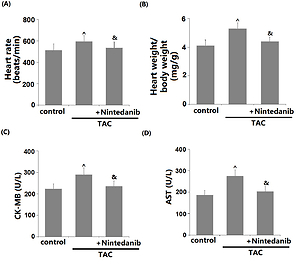Current issue
Archive
Manuscripts accepted
About the Journal
Editorial office
Editorial board
Section Editors
Abstracting and indexing
Subscription
Contact
Ethical standards and procedures
Most read articles
Instructions for authors
Article Processing Charge (APC)
Regulations of paying article processing charge (APC)
HEART FAILURE / RESEARCH PAPER
The potential protective effects of nintedanib against cardiac hypertrophy in vitro and in vivo
1
People's Hospital of Ganzhou, China
2
People's Hospital of Chongyi County, China
Submission date: 2022-07-08
Final revision date: 2022-09-05
Acceptance date: 2022-09-19
Online publication date: 2022-09-21
Corresponding author
KEYWORDS
TOPICS
ABSTRACT
Introduction:
Cardiac hypertrophy is an independent risk factor for heart failure. However, the underlying mechanisms of cardiac hypertrophy are still unclear. Nintedanib is a Food and Drug Administration (FDA) approved therapeutic agent for the treatment of progressive fibrosing lung diseases.
Material and methods:
In this study, we examined the effects of nintedanib on cardiac hypertrophy using an in vivo murine model with the transverse aortic constriction (TAC) operation and an in vitro cardiomyocytes model stimulated with Ang II.
Results:
Nintedanib has a protective effect on cardiac function in TAC mice with decreased heart rates, heart weight/body weight (HW/BW), and reduced plasma levels of creatine kinase-MB (CK-MB) and aspartate aminotransferase (AST). Wheat germ agglutinin (WGA) staining proved that the increased cardiomyocytes sizes in TAC mice were restored by nintedanib treatment. Nintedanib also reversed the decreased plasma levels of oxidative markers nuclear factor erythroid-2-related factor 2 (Nrf2), lipid peroxidation products thiobarbituric acid reactive substances (TBARS), and GSH, as well the increased homocysteine (Hcy) levels in TAC mice. In the in vitro cardiomyocytes model, cells were treated with nintedanib, followed by Ang II stimulation. Nintedanib improved Ang II induction-caused cell injury and oxidative stress in H9C2 cells, as shown by the decreased release of lactate dehydrogenase (LDH), and elevated mRNA levels of GPX1 and HO-1. Mechanistically, we prove that the protective effect of nintedanib is mediated by SIRT1.
Conclusions:
In conclusion, this study demonstrates the protective effects of nintedanib on cardiac hypertrophy both in vivo and in vitro, which was attributed to its anti-oxidative activity through regulating SIRT1 expression.
Cardiac hypertrophy is an independent risk factor for heart failure. However, the underlying mechanisms of cardiac hypertrophy are still unclear. Nintedanib is a Food and Drug Administration (FDA) approved therapeutic agent for the treatment of progressive fibrosing lung diseases.
Material and methods:
In this study, we examined the effects of nintedanib on cardiac hypertrophy using an in vivo murine model with the transverse aortic constriction (TAC) operation and an in vitro cardiomyocytes model stimulated with Ang II.
Results:
Nintedanib has a protective effect on cardiac function in TAC mice with decreased heart rates, heart weight/body weight (HW/BW), and reduced plasma levels of creatine kinase-MB (CK-MB) and aspartate aminotransferase (AST). Wheat germ agglutinin (WGA) staining proved that the increased cardiomyocytes sizes in TAC mice were restored by nintedanib treatment. Nintedanib also reversed the decreased plasma levels of oxidative markers nuclear factor erythroid-2-related factor 2 (Nrf2), lipid peroxidation products thiobarbituric acid reactive substances (TBARS), and GSH, as well the increased homocysteine (Hcy) levels in TAC mice. In the in vitro cardiomyocytes model, cells were treated with nintedanib, followed by Ang II stimulation. Nintedanib improved Ang II induction-caused cell injury and oxidative stress in H9C2 cells, as shown by the decreased release of lactate dehydrogenase (LDH), and elevated mRNA levels of GPX1 and HO-1. Mechanistically, we prove that the protective effect of nintedanib is mediated by SIRT1.
Conclusions:
In conclusion, this study demonstrates the protective effects of nintedanib on cardiac hypertrophy both in vivo and in vitro, which was attributed to its anti-oxidative activity through regulating SIRT1 expression.
Share
RELATED ARTICLE
We process personal data collected when visiting the website. The function of obtaining information about users and their behavior is carried out by voluntarily entered information in forms and saving cookies in end devices. Data, including cookies, are used to provide services, improve the user experience and to analyze the traffic in accordance with the Privacy policy. Data are also collected and processed by Google Analytics tool (more).
You can change cookies settings in your browser. Restricted use of cookies in the browser configuration may affect some functionalities of the website.
You can change cookies settings in your browser. Restricted use of cookies in the browser configuration may affect some functionalities of the website.



